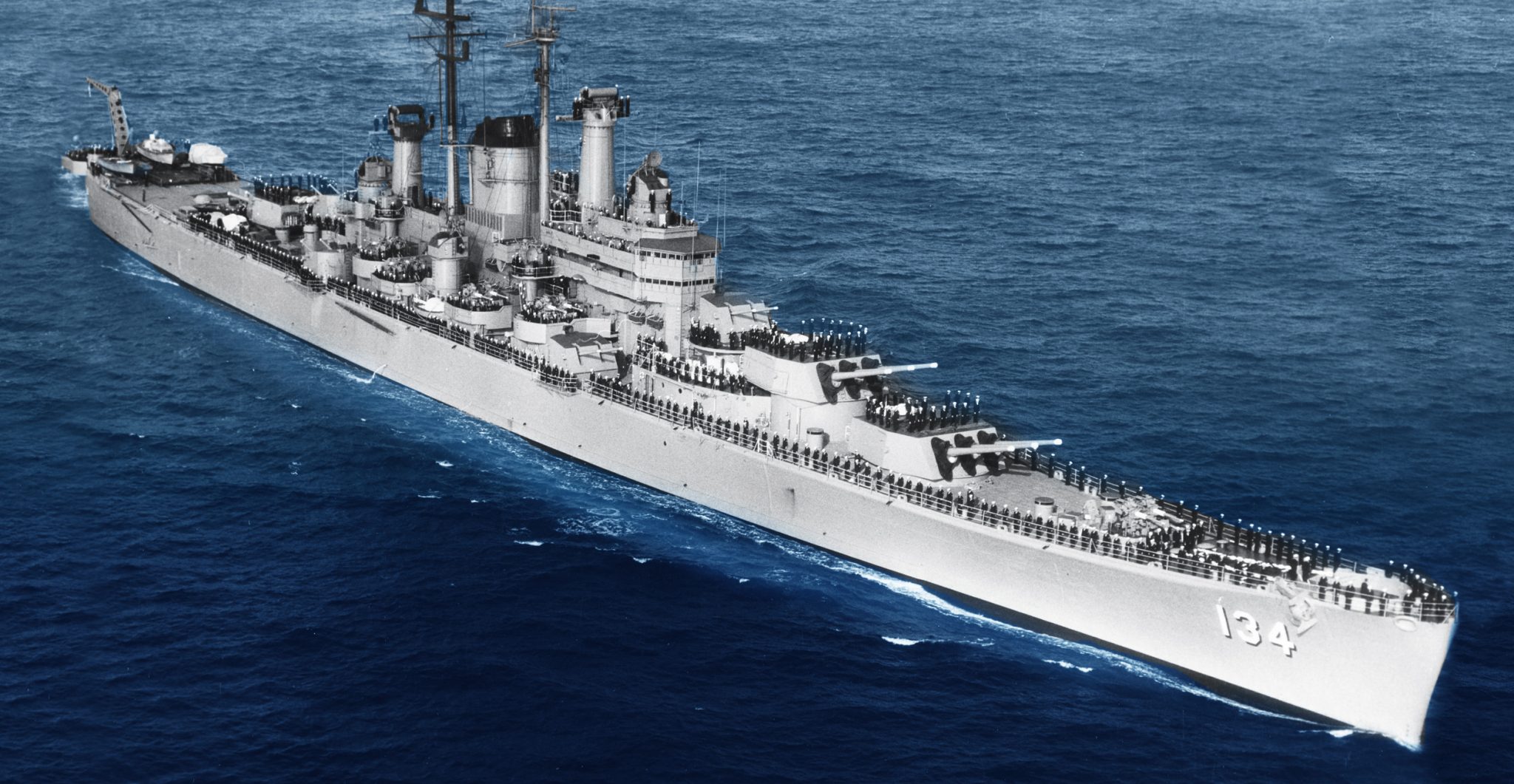War History online proudly presents this Guest Piece from Chris Knupp
Determining what would have been the greatest heavy cruiser would be a challenging task. Very successful designs were put to sea by a variety of nations. However, there was one cruiser that was born from all cruisers before it. This class of warship took the lessons from World War 2 and was designed around them. The vessel I speak of is the Des Moines class cruiser. A little-known cruiser due to its late introduction, the Des Moines found itself overshadowed by the emergence of ship-launched missiles. Despite serving for almost 25 years, their capabilities are largely unknown. What makes these ships the greatest heavy cruiser designs and how were they developed as such?
The Design
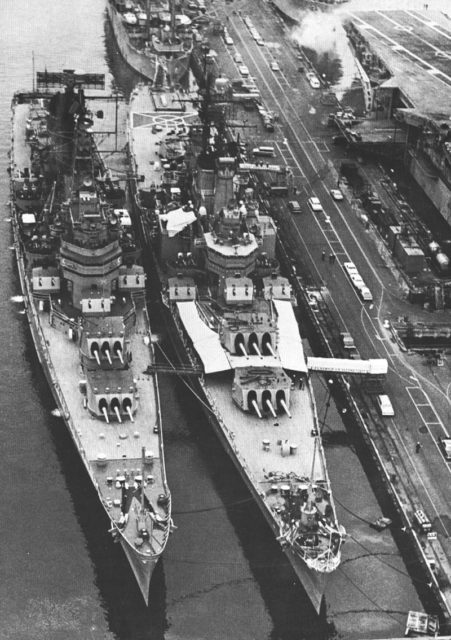
USS Newport News (Des Moines class) alongside USS Boston (Baltimore class). The Larger size of the Des Moines class is evident, especially her larger turrets.
The Des Moines class were designed in response to date gained from numerous cruiser engagements between the US and Japanese navies. While faring well against Japanese cruisers in gunnery duels, US cruisers had experienced heavy losses from Japanese destroyers and their deadly long lance torpedoes. US Designers sought to create a more powerful cruiser with better protection against underwater attacks as well as enough firepower to quickly sink enemy surface ships. As the effectiveness of aircraft was becoming apparent, the US also sought to increase anti-air firepower. Essentially, the goal was to create a cruiser that could outfight anything the enemy was likely to field.
Designers used the current Baltimore class heavy cruiser as a basis for the new design. A larger hull was needed to improve resistance to torpedoes while also supporting stronger armor and more powerful weaponry. A Baltimore class cruiser was 673′ in length with a 70′ beam. They displaced almost 17,000 tons at full load. Their successor grew to 716′ in length with a 76′ beam. The Des Moines class displaced almost 21,000 tons at full load. This greater size was needed to handle the additional armor and heavier weaponry.
Firepower
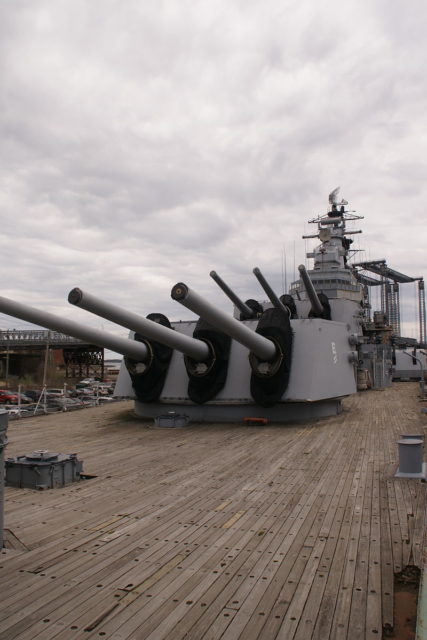
The 8″/55 Mark 16 guns onboard USS Salem. The circular hatches under the gun barrels are for ejecting spent shell casings.
Firepower was a primary design goal for the Des Moines class and they had it in spades. They retained the standard 8″/55 caliber guns from earlier US cruisers but used the modernized mark 16 design. The biggest enhancement was that the guns were auto loading, giving them a rate of fire of 12 rounds per minute. This allowed a Des Moines class cruiser to expel 3 times the amount of firepower compared to earlier cruisers that had a rate of fire of roughly 4 rounds per minute. A breakdown of firepower weight between the Des Moines class and some of its adversaries can be seen below.
Firepower weight per minute:
- Baltimore class (AP Shells)- 12,060 lbs. per minute
- Mogami class (AP Shells) – 11,080 lbs. per minute
- Admiral Hipper class (AP Shells) – 10,760 lbs. per minute
- Algerie class (AP Shells) – 10,840 lbs. per minute
- Des Moines class (AP Shells) – 36,180 lbs. per minute
Secondary Firepower
As the table shows, as far as main battery firepower is concerned, the Des Moines class is unrivaled. Had she met another cruiser in combat she would have had an overwhelming firepower advantage.
Supporting the larger 8″ guns was a smaller battery of twelve 5″ dual purpose guns carried over from previous cruiser designs. These excellent weapons were the mainstay of US warships throughout WW2. Providing the main anti-air firepower was the new 3″/50 Rapid Fire gun. These cannons replaced the Bofors 40mm auto cannons following World War 2. The 3″/50 was the smallest gun able to use VT fused shells and could obliterate an aircraft with a direct hit. Post-war testing done by the US Navy showed that a single 3″/50 was as effective as eight 40mm Bofors guns. The Des Moines carried 24 of these weapons in twelve twin mounts. Rounding out the anti-air firepower were twelve 20mm Oerlikon autocannons.
Armor
The armoring the Des Moines class was relatively unchanged from the preceding Baltimore class cruiser. Like the Baltimore class, she carried a heavy 6″ belt over her magazines and machinery. This was over 50% thicker than the Armor belts found on her German and Japanese rivals. In response to the threat of air attack, the Des Moines cruisers did receive thicker deck armor that measured 3.5″ over her vitals. This was substantially thicker than the cruisers of other nations.
During the naval battles at Guadalcanal and other early engagements, Japanese shells had crippled US warships by knocking out guns and killing bridge crews. Learning from these events, the Des Moines class also received much thicker armor over her conning tower (6.5″) and gun turrets (8″). This was done to ensure that small caliber shells and shrapnel would not easily hamper her ability to fight. Not only would the Des Moines class be expected to outgun the opposition, but she was to outlast it as well.
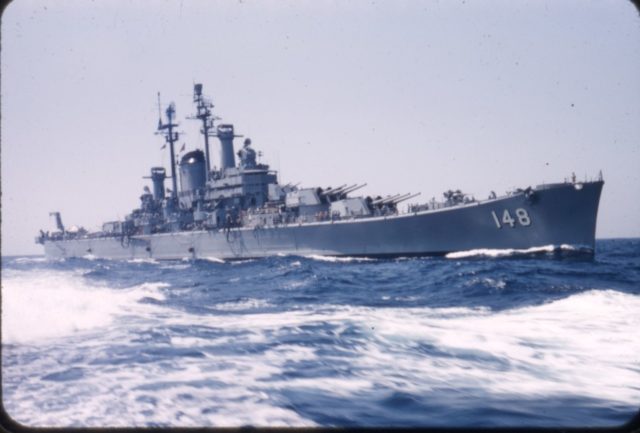
Propulsion
Despite displacing over 4000 additional tons compared to the Baltimore class cruiser, the Des Moines utilized the same boilers and turbines. However, they were still sufficient to get the ship up to a speed of 33 knots. Her larger size also allowed her to carry a substantial amount of fuel, allowing her to cruise for over 10,500 nautical miles.
The biggest enhancement to the power plant of the Des Moines class was the arrangement of the engines. By rearranging the power plant, the Des Moines was able to trunk all exhaust gases into a single funnel. This had the benefit of greatly improving the firing arcs of all the anti-aircraft weapons. As an added bonus, it became less likely that a torpedo would knock out the engines. This seemingly minor modification increased the ships anti-air firepower while also improving its resistance to underwater attacks.
Conclusions
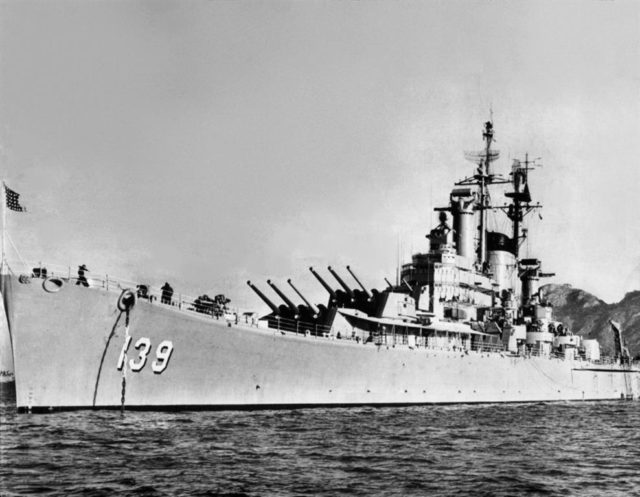
USS Salem in 1957, at this time she was the last and only heavy cruiser in the world.
Ironically, despite being born from the lessons of World War 2, the Des Moines class ships were not completed in time to take part in the war. It is a shame as one could only imagine the results had the Des Moines been able to participate in a cruiser battle like Guadalcanal or Surigao Strait. With their heavy firepower and thick armor, they would have fared well against the Japanese heavy cruisers. Instead, the Des Moines class ships spent their careers showing the US flag throughout the world. What little action they saw were gunnery support missions off of Korea and Vietnam. However, their service was said to be stellar and they are remembered fondly by those who served on them.
Despite their great power, they could not compete against time and advancing technology. Despite that, their overwhelming advantage over all over heavy cruisers is apparent. Had she arrived a little earlier, the Des Moines class could have been a force to be reckoned with. Even taking her late arrival into account, without a doubt, the Des Moines class was the greatest heavy cruiser class ever put to sea.
About the Author
Chris Knupp has written several articles on various aspects of military history and technology. He predominately covers modern history following the First World War. You can read more of his articles at his personal website or follow him through social media.
